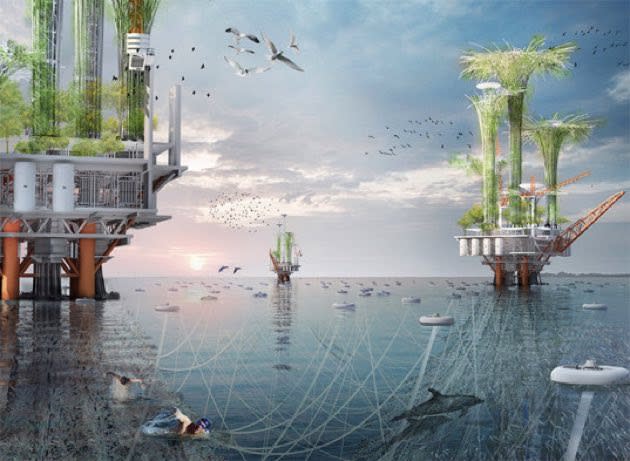Inhabitat's Week in Green: oil rig oasis, bio-pyramids and Facebook's new home

Each week our friends at Inhabitat recap the week's most interesting green developments and clean tech news for us -- it's the Week in Green.
Tesla, the Silicon Valley-based electric carmaker, is unrivaled when it comes to automotive innovation, and now the company is moving beyond the garage and into the home. Tesla CEO Elon Musk revealed earlier this year that the company is developing a house battery that could help homeowners go off the grid. But Musk isn't done: He also announced that Tesla would release a new product -- one that it isn't a car -- at the end of April. Will it be the house battery? We'll just have to wait and see.
The New York Auto Show kicked off last week, with press reveals of some of hottest new hybrids and EVs, and Inhabitat was on the scene to get an early look. For the second year in a row, BMW took the Green Car Award for the BMW i8, a sleek hybrid that has an all-electric range of 23 miles and can go from 0 to 60 in just 4.4 seconds. Chevrolet made a big splash with two separate reveals at the show: the faster and more efficient 2016 Spark and the 2016 Malibu Hybrid, which is more efficient thanks to technology borrowed from the 2016 Chevy Volt. On the luxury side of things, Lexus took the wraps off the 2016 Lexus RX 450h Hybrid, which features a sportier exterior than previous models and is offered with a V6 hybrid powertrain. And in the urban category, Smart unveiled the new 2016 Fortwo, which is just 8.8 feet long, but features more space than older models. And on the other side of the country, Inhabitat test-drove the Mercedes-Benz B-Class Electric Drive and the BMW i3 on the streets of Los Angeles for a head-to-head comparison. Click through to find out which high-end EV is better.
The winners of eVolo Magazine's annual skyscraper competition were announced last week, and Polish firm BOMP took top honors for its Essence Skyscraper project. Among this year's honorable mentions was an enormous bio-pyramid that would enclose the Egyptian pyramids inside a greenhouse-like biosphere. Designing structures that help to regenerate biodiversity was a major theme of this year's competition. The cellular Re-Generator Skyscraper, designed by Gabriel Munoz Moreno, would grow like a living organism and help China's Hangzhou wetlands to recover. The Noah Oasis project proposed transforming offshore oil rigs into bio-habitats that would clean up oil spills and restore damaged marine ecosystems. In a proposal that sounds like pure sci-fi, Chinese designer Qidan Chen drew up plans for a skyscraper complex that would facilitate the artificial reproduction of animal and plant species. A team from China proposed building a radiant skyscraper that would purify the air and water in Chernobyl, absorbing radiation and giving off soft- or high-intensity light. And a team of Malaysian designers produced plans for converting former mining sites into housing.
Green design is important, but green design that addresses a social need is even better. Paul Lukez Architecture has done the latter by designing a small, "energy plus" home for a schoolteacher who wanted to stay in the Boston area despite the ever-rising cost of housing. Facebook officially moved into its new Frank Gehry-designed, LEED-certified headquarters in Menlo Park last week. The building features a sprawling green roof and a vibrantly decorated interior. Italian architecture firm Piuarch unveiled designs for the ENEL Pavilion at the upcoming Milan World Expo. The structure will be a physical representation of a smart energy grid using 650 vertically oriented polycarbonate vectors. And on the furniture design front, Christian Sjöström rolled out a new line of modular furniture inspired by molecular structures.
The Solar Impulse 2 landed in China last week, continuing its quest to become the first solar-powered airplane to fly around the world. The plane, which is piloted by a pair of Swiss aviators, will make one more stop in China before heading to Hawaii. In other green energy news, Facebook might be dipping its toe in the solar-powered drone market. Their in-the-works drone, which is the size of a commercial jet, would beam internet signals to communities that lack data networks. Scientists at the University of Texas at Dallas are working to develop a new kind of plastic used in tubing that can produce electricity when stretched. The material could have revolutionary effects on both green energy and medical applications. Workers recently broke ground on the UK's first zero-carbon community, North West Bicester, and the first residents are expected to move into 393 zero-carbon homes later this year. And one town in Texas -- the heart of America's oil country -- is expected to run on 100 percent clean energy by 2017. Georgetown, a town of about 50,000, is located near Austin (of course). Israel installed 1,500 solar panels at the country's national assembly in Jerusalem, making it the largest solar field of any parliament in the world. And for renewable energy on the go, there's no better option than the Pulse, the world's first hybrid portable charger, which can draw energy either from a wall outlet or from a solar panel.


